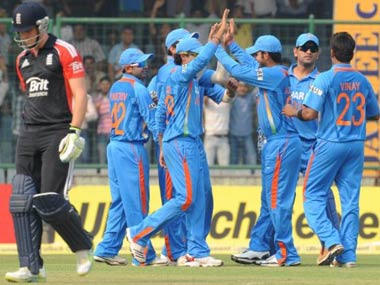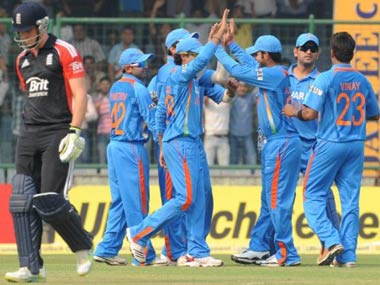As Virat Kohli and Gautam Gambhir gave England a hiding that they would remember for a long time, one couldn’t help but wonder how a side that looked so good at home less than a month back were playing like utter novices now. Yes, the Indians played great cricket. They bowled and fielded well and then the batsmen batted with such ease and comfort that the match was almost boring to watch. England, on the other hand, was tentative from the word ‘go.’ In the first ODI, they were undone by the spinners while batting second. So at Kotla, for the second ODI, they changed tactics. After winning the toss, they promptly elected to bat first. It seemed like a wise choice, especially when you consider the slow nature of the Delhi wicket. And it would have been wise too if only the England management was actually doing it with a plan in mind. [caption id=“attachment_110542” align=“alignleft” width=“380” caption=“India need to learn how to win away from home. AFP”]
 [/caption] But sadly, the only plan England had in mind was to reduce the impact of the Indian spinners somehow. In the final count, they managed to do that by giving Vinay Kumar his career-best figures of 4-30. There was simply no escape and that’s the case with most teams visiting India – there are far too many things to factor in and too little time to put what you learn into practice. In essence, the tables have been turned on the England team by an Indian team that is still lacking many first-team players. So what brought about this change? Many will argue that acclimatisation doesn’t really count for much. But England and earlier, India’s results over the past few months shows that it can make a big difference. With IPL and other tours, the opposition probably know the conditions in India a little better than previously. But they can never get the same kind of know-how as somehow who’s been playing in these conditions for 20 years or more. But the question we really need to be asking is that if Indians are good in India and English are good in England, then which is the better side? If the two were to clash at a neutral venue, which team would come out on top? There was a time, not very long ago, when this argument didn’t really matter because Australia were winning – here, there, everywhere. It was firmly established that the good teams win at home but the great teams win away as well. Not the odd Test but complete series’ because that was the only way to prove your credentials. Not rankings, not trophies – simple results. Before that, we had West Indies do that. And there have been instances when Pakistan, India, New Zealand and South Africa have been competitive away from home as well. And that’s the real test. For England and India – all the talk of number one has no meaning – if they can’t win away from home. Yes, these wins are important for India. But at the end of the day, they only prove what we already knew, India are tough to beat at home; in fact, they are very tough to beat at home. And for England too, the wins in England mattered. They were up against the best Test team in the world and they thoroughly slaughtered them. But then when you see them walk around like lost sheep, you can’t help but wonder… how do top teams lose the plot so easily? It was a question that dogged India every step of the way in England and now it rears its head again. And once again, we have no answers.
[/caption] But sadly, the only plan England had in mind was to reduce the impact of the Indian spinners somehow. In the final count, they managed to do that by giving Vinay Kumar his career-best figures of 4-30. There was simply no escape and that’s the case with most teams visiting India – there are far too many things to factor in and too little time to put what you learn into practice. In essence, the tables have been turned on the England team by an Indian team that is still lacking many first-team players. So what brought about this change? Many will argue that acclimatisation doesn’t really count for much. But England and earlier, India’s results over the past few months shows that it can make a big difference. With IPL and other tours, the opposition probably know the conditions in India a little better than previously. But they can never get the same kind of know-how as somehow who’s been playing in these conditions for 20 years or more. But the question we really need to be asking is that if Indians are good in India and English are good in England, then which is the better side? If the two were to clash at a neutral venue, which team would come out on top? There was a time, not very long ago, when this argument didn’t really matter because Australia were winning – here, there, everywhere. It was firmly established that the good teams win at home but the great teams win away as well. Not the odd Test but complete series’ because that was the only way to prove your credentials. Not rankings, not trophies – simple results. Before that, we had West Indies do that. And there have been instances when Pakistan, India, New Zealand and South Africa have been competitive away from home as well. And that’s the real test. For England and India – all the talk of number one has no meaning – if they can’t win away from home. Yes, these wins are important for India. But at the end of the day, they only prove what we already knew, India are tough to beat at home; in fact, they are very tough to beat at home. And for England too, the wins in England mattered. They were up against the best Test team in the world and they thoroughly slaughtered them. But then when you see them walk around like lost sheep, you can’t help but wonder… how do top teams lose the plot so easily? It was a question that dogged India every step of the way in England and now it rears its head again. And once again, we have no answers.
India win in India, England win in England… So who’s better?
Ashish Magotra
• October 18, 2011, 14:07:45 IST
For England and India – all the talk of number one has no meaning – if they can’t win away from home.
Advertisement
)
End of Article